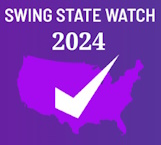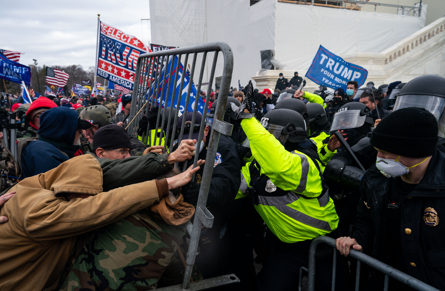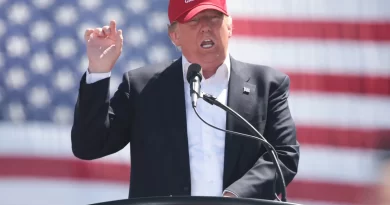Trump Spreads Election Misinformation in Key States
Este artículo estará disponible en español en El Tiempo Latino.
In speeches in Nevada and Arizona, former President Donald Trump continued to spread misinformation that undermines public confidence in state and federal elections:
- Trump claimed that Kari Lake lost the Arizona governor’s race in 2022 because Maricopa County “machines just happened to be broken” — falsely adding, “only the Republican machines.” Some printers produced ballots that were too light for on-site tabulators, but the ballots could be counted later. Lake’s court challenges failed, and an independent review found no evidence of wrongdoing.
- Trump also claimed, without evidence, that Abraham Hamadeh lost the 2022 attorney general’s race in Arizona because “his election was rigged.” A recount confirmed Hamadeh lost the election, and court challenges failed, too, due to a lack of evidence.

In Nevada, Trump — who was indicted by a federal grand jury for allegedly conspiring to remain in office despite losing the 2020 presidential election — whitewashed the violence on Jan. 6, 2021, when his supporters attacked the U.S. Capitol as Congress met to count the electoral votes that would declare Joe Biden the winner.
“All they were doing is protesting a rigged election. And then the police say, ‘Go in, go in’” to the Capitol, he said of his supporters. “What a setup that was.”
As we have written before, nearly 140 law enforcement officers were injured trying to keep the protesters out of the U.S. Capitol that day, according to official reports. There’s also no evidence the 2020 election was “rigged” or that Trump supporters were the victims of an FBI “setup.”
Trump, the presumptive presidential nominee of the Republican Party, made his remarks at a town hall event in Phoenix on June 6 and at a rally in Las Vegas on June 9. The former president lost Arizona and Nevada to Biden in 2020. Biden won by only 10,457 votes in Arizona, which remains a key swing state in 2024.
Kari Lake’s Defeat
As presidential candidates usually do when visiting a state, Trump introduced some of Arizona’s Republican candidates when he spoke in Phoenix — including Hamadeh, a House candidate for the 8th Congressional District, and Lake, who is now running for the U.S. Senate.
In his introductions, Trump falsely claimed that the U.S. doesn’t have “honest elections,” and went on to baselessly claim that Hamadeh and Lake were victims of election fraud in 2022.
Trump, June 6: A congressional candidate who’s doing a really terrific job — his election was rigged the last time, I will tell you that. They don’t like — they say, “Oh, please. Don’t say that.” These elections, let me tell, if we could have honest elections in this country, I would have stopped campaigning two weeks ago. We would’ve had it made. But we don’t have that. … Congressional candidate, Abe Hamadeh.
And a friend of mine, and a really incredible woman, who’s worked very hard, and she had another one of those elections, the machines just happened to be broken. Only the Republican machines, however. That was a strange situation. She had lines going back 2 miles. And I’m sorry, sir, you’ll have to come back about 12 o’clock in the evening. The machines happen to be broken.
Let’s look at Lake’s election first, and Trump’s false claim that she lost because “Republican machines” failed on Election Day.
Lake lost the 2022 governor’s race to then-Secretary of State Katie Hobbs by more than 17,000 votes. She blamed her defeat on election fraud, making multiple claims in a lawsuit filed Dec. 9, 2022 — including one that Trump referenced when he spoke of “broken machines.”
Trump is referring to a problem with Maricopa County’s ballot-on-demand printers at some polling locations on Election Day. As we wrote a day after the Nov. 8, 2022, election, Maricopa County said the printers produced ballots for a period of time that were too light for the on-site ballot tabulators to read. Until the problem was resolved, election officials advised voters to leave their completed ballot in a secure box to be tabulated later.

Lake sued, claiming that her voters were disenfranchised. But she lost her lawsuit and subsequent appeals.
“Plaintiff’s own expert acknowledged that a ballot that was unable to be read at the vote center could be deposited by a voter, duplicated by a bipartisan board onto a readable ballot, and—in the final analysis—counted,” Maricopa County Superior Court Judge Peter Thompson wrote in his Dec. 24, 2022, decision.
Nearly eight weeks later, a state appeals court upheld Thompson’s ruling, dismissing Lake’s complaint about disenfranchised voters as “sheer speculation.”
“Lake’s claim thus boils down to a suggestion that election-day issues led to long lines at vote centers, which frustrated and discouraged voters, which allegedly resulted in a substantial number of predominately Lake voters not voting. But Lake’s only purported evidence that these issues had any potential effect on election results was, quite simply, sheer speculation,” the Arizona Court of Appeals, Division One, wrote in a Feb. 16, 2023 ruling.
Lake appealed, but the state Supreme Court declined to hear her case.
“The Court of Appeals aptly resolved these issues, most of which were the subject of evidentiary proceedings in the trial court, and Petitioner’s challenges on these grounds are insufficient to warrant the requested relief under Arizona or federal law,” the high court said.
There is also no evidence that the printer failure was part of a plot to elect a Democrat.
“The premise that Vote Centers with issues were ‘Republican Machines’ isn’t possible,” Jennifer Liewer, a spokesperson for the county elections department, told us in an email. “Maricopa County uses a vote anywhere model so a voter can check in to any Vote Center, have their ballot printed, and then tabulated on election day. There are not ‘republican’ or ‘democrat’ Vote Centers.”
In our analysis of the precincts with the problematic printers, we found more than 70,000 votes were cast for the Democratic and Republican candidates in each of the gubernatorial and attorney general races, and the votes were roughly equally divided between the two major party candidates.
But what caused the problem?
The county attorney’s office hired a retired judge to determine what happened and how the county can prevent it from happening again.
In a report, released April 10, 2023, former Arizona Supreme Court Chief Justice Ruth McGregor blamed “equipment failure” for the problems on Election Day. Some of the on-site printers couldn’t “reliably” print the general election ballots, which were longer and heavier than those used in the primary election, the report said. The printer problems occurred at 37 of the county’s 223 vote centers, Liewer told us.
“[T]he primary cause of the election day failures was equipment failure,” McGregor’s report said. “Despite the assurances of the manufacturer, many of the Oki B432 printers were not capable of reliably printing 20-inch ballots on 100-pound paper under election-day conditions. Any failure in process or human error relates to a failure to anticipate and prepare for the printer failures experienced. But nothing we learned in our interviews or document reviews gave any clear indication that the problems should have been anticipated.”
McGregor’s report provided some idea of the scope of the problem: “Two-thirds of the general election vote centers reported no issues with misprinted ballots; approximately 94 percent of election day ballots were not faulty.”
Lastly, there was no recount in the governor’s race, because the race wasn’t close enough to trigger a mandatory recount. But there were hand audits performed in 12 of the state’s 15 counties, including Maricopa, which audited the governor’s race, as well as two other races and a ballot question.
State law requires county election officers to count “a sample of ballots to test the accuracy of the vote tabulation equipment if there is participation from the county political parties,” as explained on the secretary of state website. All 12 counties that participated passed the audit — including Maricopa. The audit involved about 5,000 ballots in Maricopa County and resulted in no net change for Lake or Hobbs.
Abraham Hamadeh’s Defeat
Trump also claimed that Hamadeh’s election — which was a lot closer than Lake’s election — was “rigged.” But again, the losing Republican candidate failed to produce the evidence needed to convince the courts.
Hamadeh lost the 2022 attorney general’s race to Democrat Kris Mayes by only 280 votes out of 2.5 million ballots — and that was after a statewide recount that cut Mayes’ lead nearly in half, according to the official results.
Like Lake, Hamadeh claimed, among other things, that “thousands of voters were disenfranchised” in Maricopa County, and he sought to overturn the election results. Hamadeh filed a complaint in Mohave County Superior Court on Dec. 9, 2022. But, notably, the complaint did not allege fraud or wrongdoing.
“The Plaintiffs are not, by this lawsuit, alleging any fraud, manipulation or other intentional wrongdoing that would impugn the outcomes of the November 8, 2022, general election,” the complaint read, according to AZCentral, a news website that includes the state’s largest newspaper, the Arizona Republic.
At a Dec. 23, 2022, hearing, Hamadeh’s attorney, Timothy La Sota, repeated to the court that the complaint was not alleging fraud. “We said in our complaint we are ‘not alleging any fraud, manipulation or other intentional wrongdoing,’” La Sota said. “So, we did not allege intentional misconduct.”
That same day, Mohave County Superior Court Judge Lee F. Jantzen rejected Hamadeh’s lawsuit. “The bottom line is you just haven’t proven your case,” Jantzen told La Sota.
Hamadeh filed a motion for a new trial, but Jantzen denied the motion. In his July 17, 2023, ruling, Jantzen said that Hamadeh failed to satisfy the requirements for a new trial, because there were no irregularities or errors of law in the first trial, and there was no “newly discovered material evidence that could not have been discovered” at the first trial.
Days later, Hamadeh appealed Jantzen’s decision to the Arizona Court of Appeals, which rejected Hamadeh’s motion in a 2-1 ruling in April.
“A virtual firestorm of challenges followed the 2022 general election. Those flames have subsided. The winners were announced and took their oaths of office more than 15 months ago,” Chief Judge David B. Gass wrote for the majority. “This case, one of the last embers still glowing, does not burn hot enough to warrant relief.”
Protesters at U.S. Capitol and the ‘Rigged’ Election
In Nevada, Trump once again minimized the actions of those who stormed the U.S. Capitol on Jan. 6, 2021, saying his supporters were only there to protest a “rigged election” and falsely alleging that police told protesters to “go in” to the Capitol.
We have debunked this bit of revisionist history on more than one occasion from others who sought to distort the mission and actions of the officers that day.
In reality, the police were trying to prevent the crowd that attended Trump’s “Save America” rally at the White House Ellipse from disrupting the electoral vote count that was scheduled for that same day at the Capitol.

In the course of defending the Capitol and protecting the vice president and lawmakers and their staffs, the U.S. Capitol Police said 73 of its officers were injured, and the Metropolitan Police Department of the District of Columbia reported 65 injuries, according to a bipartisan report by two Senate committees.
“Throughout the seven hours of the riot on the Capitol grounds, law enforcement officers faced verbal and ‘absolutely brutal,’ violent physical abuse,” the report said. “One officer described an interaction with a group of protestors during the evacuation of the Senate: ‘[W]e stopped several men in full tactical gear and they stated ‘You better get out of our way boy or we’ll go through you to get [the Senators].’”
The report said the officers were “physically assaulted with a range of objects thrown from the crowds, pinned against surfaces, and beaten with flag poles and other weapons carried or found by rioters, including frozen water bottles.” The rioters also used pepper spray and other chemical irritants against officers.
Trump has called the rioters “patriots,” “hostages” and “warriors,” hinting that he would pardon them if he becomes president again. He said in Nevada that they were victims of “a setup” — which is a reference to a debunked theory that the FBI infiltrated and egged on the pro-Trump supporters, so they could be arrested.
As we have written, FBI Director Christopher Wray, who was appointed by Trump, addressed that discredited theory at a congressional hearing in November 2022. “To the extent that there’s a suggestion, for example, that the FBI’s confidential human sources or FBI employees in some way instigated or orchestrated January 6 — that’s categorically false,” Wray told Congress.
The notion that the 2020 presidential election was “rigged” is equally without merit.
William Barr, who served as the U.S. attorney general under Trump, told a House committee in testimony released June 13, 2022: “In my opinion then, and my opinion now, is that the election was not stolen by fraud, and I haven’t seen anything since the election that changes my mind on that.”
After the election, top White House aides and other Justice Department officials also told Trump there was no evidence of widespread fraud, but that hasn’t prevented Trump from repeating false fraud claims then and now.
Editor’s note: FactCheck.org does not accept advertising. We rely on grants and individual donations from people like you. Please consider a donation. Credit card donations may be made through our “Donate” page. If you prefer to give by check, send to: FactCheck.org, Annenberg Public Policy Center, 202 S. 36th St., Philadelphia, PA 19104.

